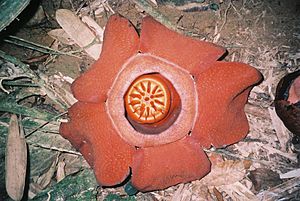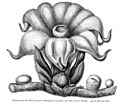Rafflesiaceae facts for kids
Quick facts for kids Rafflesiaceae |
|
|---|---|
 |
|
| Rafflesia kerrii flower | |
| Scientific classification | |
| Kingdom: | |
| (unranked): | |
| (unranked): | |
| Order: | |
| Family: |
Rafflesiaceae
|
Rafflesiaceae is a special family of flowering plants. They belong to the Malpighiales order. These plants are unique because they are parasitic. This means they get their food and water from other plants.
You can find Rafflesiaceae plants in East and Southeast Asia. One very famous plant from this family is Rafflesia arnoldii. It is known for having the largest flower of any plant in the world!
Contents
About Rafflesiaceae Plants
Rafflesiaceae plants are quite unusual. They do not have leaves, stems, or roots like most plants. Instead, they live inside the tissues of other plants. They get all their nutrients from their host plant. This way of life is called parasitism.
How Do Parasitic Plants Get Food?
Imagine a plant that doesn't need sunlight to make its own food. That's a parasitic plant! Rafflesiaceae plants attach themselves to the roots or stems of other plants. They use special structures to draw water and nutrients from their host. This allows them to grow without needing their own leaves for photosynthesis.
The World's Largest Flower
The most famous member of the Rafflesiaceae family is Rafflesia arnoldii. This plant produces the largest single flower on Earth. Its flower can grow to be over 3 feet (1 meter) wide! It can also weigh up to 22 pounds (10 kilograms). The flower has a reddish-brown color and a strong, unpleasant smell. This smell helps to attract insects like flies. These insects then help the plant to spread its pollen.
Where Do Rafflesiaceae Grow?
These interesting plants are found in tropical rainforests. They live in countries across East and Southeast Asia. This includes places like Indonesia, Malaysia, Thailand, and the Philippines. They need warm, humid environments to survive. They also need specific host plants to grow on.
Images for kids
See also
 In Spanish: Rafflesiaceae para niños
In Spanish: Rafflesiaceae para niños


